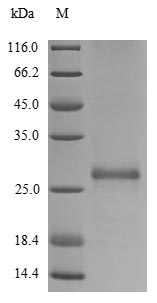Recombinant Human Glutathione S-transferase P (GSTP1) is produced in a yeast expression system, which appears to ensure high fidelity of protein folding and stability. The full-length mature protein spans amino acids 2 to 210. It comes with an N-terminal 10xHis-tag that makes purification and detection in research applications more straightforward. SDS-PAGE verification shows the purity exceeds 90%, suggesting this protein may be a reliable tool for biochemical assays and experimental studies.
Glutathione S-transferase P (GSTP1) belongs to the glutathione S-transferase family. These enzymes seem to play a crucial role in detoxifying both endogenous and exogenous compounds through conjugation with glutathione. GSTP1 is likely involved in cellular processes like detoxification and protection against oxidative stress. This makes it a significant focus in research related to cancer, drug resistance, and toxicology studies.
Potential Applications
Note: The applications listed below are based on what we know about this protein's biological functions, published research, and experience from experts in the field. However, we haven't fully tested all of these applications ourselves yet. We'd recommend running some preliminary tests first to make sure they work for your specific research goals.
Human GSTP1 is a glutathione S-transferase that requires precise folding and dimerization for its enzymatic activity in detoxification processes. The yeast expression system provides a eukaryotic environment that supports proper folding, disulfide bond formation, and dimerization. The N-terminal 10xHis tag is relatively small and unlikely to significantly interfere with the protein's functional domains or dimerization interface. While yeast expression provides better folding conditions than bacterial systems, experimental validation remains essential to confirm functional activity.
1. Protein-Protein Interaction Studies Using His-Tag Pull-Down Assays
This application's reliability depends on proper folding validation. Protein-protein interactions require precise tertiary and quaternary structure. If correctly folded (verified), the protein is suitable for identifying physiological interaction partners in detoxification pathways. If misfolded/unverified, the risk of non-specific binding makes results biologically misleading.
2. Antibody Development and Validation
Antibody development relies on antigenic sequence recognition. If correctly folded (verified), the protein excels for generating conformation-sensitive antibodies. If misfolded/unverified, it remains suitable for producing antibodies against linear epitopes.
3. Biochemical Characterization and Enzyme Kinetics Studies
These studies are essential for determining folding status and functional competence. If correctly folded (verified), characterization provides reliable enzymatic data. If misfolded/unverified, analysis yields physical property data, but enzymatic assays will fail.
4. Inhibitor Screening and Drug Discovery Research
Functional screening requires native enzyme activity. If correctly folded (verified), the protein enables valid inhibitor screening. If misfolded/unverified, screening assays will yield misleading results.
Final Recommendation & Action Plan
The yeast expression system provides good eukaryotic folding conditions, but experimental validation is essential before functional applications. Begin with Application 3 (Biochemical Characterization) to assess folding quality through size-exclusion chromatography (dimerization check) and validate enzymatic activity using GST substrates like CDNB. If correct folding and activity are verified, proceed confidently with Applications 1, 2 (conformational antibodies), and 4 for interaction studies, antibody development, and inhibitor screening. If misfolding is detected, limit applications to linear epitope antibody production (Application 2) and basic biophysical characterization, avoiding all functional studies. For reliable GSTP1 research, always include appropriate activity controls and consider the protein's dimeric nature in experimental design.






